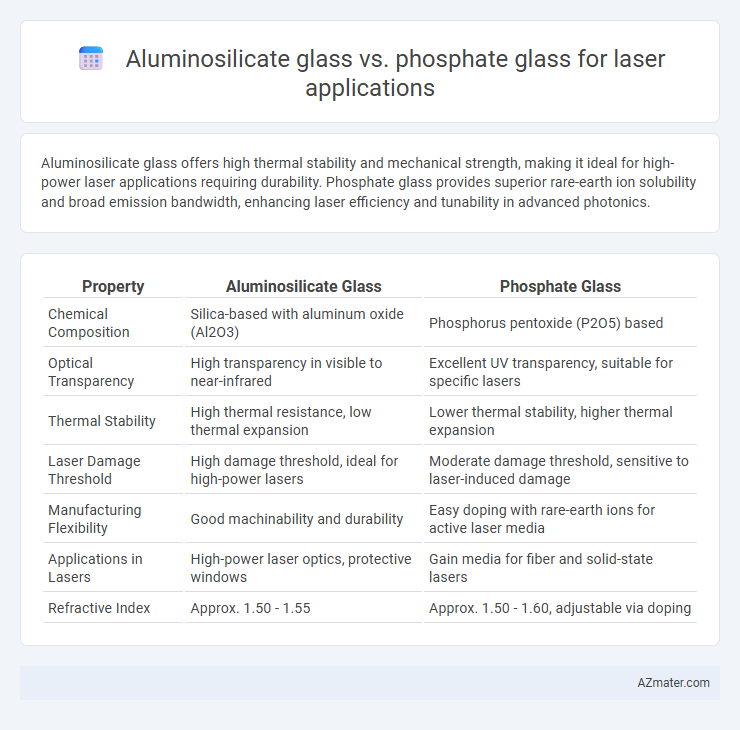Aluminosilicate glass offers high thermal stability and mechanical strength, making it ideal for high-power laser applications requiring durability. Phosphate glass provides superior rare-earth ion solubility and broad emission bandwidth, enhancing laser efficiency and tunability in advanced photonics.
Table of Comparison
| Property | Aluminosilicate Glass | Phosphate Glass |
|---|---|---|
| Chemical Composition | Silica-based with aluminum oxide (Al2O3) | Phosphorus pentoxide (P2O5) based |
| Optical Transparency | High transparency in visible to near-infrared | Excellent UV transparency, suitable for specific lasers |
| Thermal Stability | High thermal resistance, low thermal expansion | Lower thermal stability, higher thermal expansion |
| Laser Damage Threshold | High damage threshold, ideal for high-power lasers | Moderate damage threshold, sensitive to laser-induced damage |
| Manufacturing Flexibility | Good machinability and durability | Easy doping with rare-earth ions for active laser media |
| Applications in Lasers | High-power laser optics, protective windows | Gain media for fiber and solid-state lasers |
| Refractive Index | Approx. 1.50 - 1.55 | Approx. 1.50 - 1.60, adjustable via doping |
Introduction to Laser Glass Materials
Aluminosilicate glass is widely used in laser applications due to its high thermal stability, excellent mechanical strength, and low nonlinear refractive index, which enhances beam quality and power handling. Phosphate glass offers superior rare-earth ion solubility and higher gain efficiency, making it ideal for high-energy, short-pulse lasers with broad emission bandwidths. Both materials play critical roles in laser technology, balancing durability and optical performance for specific laser system requirements.
Overview of Aluminosilicate Glass
Aluminosilicate glass is highly valued in laser applications due to its exceptional thermal stability and mechanical strength compared to phosphate glass. Its unique composition, rich in aluminum oxide and silicon dioxide, enables superior resistance to thermal shock and higher laser-induced damage thresholds. These properties make aluminosilicate glass ideal for high-power laser systems requiring durability and consistent optical performance.
Overview of Phosphate Glass
Phosphate glass offers exceptional rare-earth ion solubility and high gain efficiency, making it ideal for laser applications requiring intense energy output and short pulse generation. Its lower melting temperature and superior thermal stability compared to aluminosilicate glass enhance dopant incorporation and reduce thermal strain during laser operation. This glass type also exhibits wide transmission windows in the near-infrared region, optimizing performance for high-power fiber lasers and amplifiers.
Key Material Properties and Composition
Aluminosilicate glass offers superior thermal stability, high mechanical strength, and excellent chemical durability due to its high aluminum oxide content combined with silica, making it ideal for high-power laser applications. Phosphate glass, characterized by its unique phosphate network structure, provides higher rare-earth ion solubility and lower melting temperatures, which enhances laser gain efficiency and enables improved energy storage in laser media. The differing compositions lead to aluminosilicate glass excelling in robustness and thermal resistance, while phosphate glass optimizes optical performance and dopant incorporation for laser amplification.
Optical Performance in Laser Applications
Aluminosilicate glass exhibits superior optical performance in laser applications due to its high damage threshold, excellent thermal stability, and low optical absorption, enabling efficient high-power laser operation. In contrast, phosphate glass offers enhanced rare-earth ion solubility and broader emission bandwidths, which improve laser gain and tunability but generally have lower thermal and mechanical robustness. The choice between aluminosilicate and phosphate glasses depends on balancing power handling capabilities with the need for spectral performance and laser efficiency.
Thermal Stability and Durability Comparison
Aluminosilicate glass exhibits superior thermal stability with a higher glass transition temperature (typically above 1000degC) compared to phosphate glass, which generally softens around 500-600degC, making aluminosilicate more suitable for high-power laser applications requiring intense heat resistance. Durability-wise, aluminosilicate glass offers enhanced chemical resistance and mechanical strength, preventing degradation and maintaining optical properties under harsh operating conditions, whereas phosphate glass tends to be more fragile and susceptible to environmental damage. These differences make aluminosilicate glass the preferred choice in laser systems demanding long-term thermal resilience and structural integrity.
Laser Damage Thresholds: Aluminosilicate vs Phosphate
Aluminosilicate glass demonstrates higher laser damage thresholds compared to phosphate glass, making it more resilient under high-intensity laser exposure. This superior resistance stems from its robust silica-alumina network, which offers enhanced structural stability and reduced defect sites. In contrast, phosphate glass, while valuable for specific laser applications due to its higher rare-earth ion solubility, generally exhibits lower damage thresholds, limiting its use in high-power laser systems.
Manufacturing and Processing Differences
Aluminosilicate glass for laser applications offers superior chemical durability and thermal stability, enabling higher processing temperatures and enhanced resistance to thermal shock during manufacturing. Phosphate glass, characterized by lower melting points and higher rare-earth ion solubility, allows for easier doping and faster fabrication but exhibits reduced mechanical strength and moisture resistance. Manufacturing aluminosilicate glass involves prolonged melting and controlled annealing to minimize defects, whereas phosphate glass processing benefits from simpler melting conditions but requires stringent moisture control to maintain optical performance.
Cost and Scalability Considerations
Aluminosilicate glass offers lower production costs and superior scalability for laser applications due to abundant raw materials and mature manufacturing processes. Phosphate glass, while providing excellent optical properties like high rare-earth ion solubility, incurs higher costs and faces scalability challenges related to specialized fabrication techniques. Cost-effective mass production of aluminosilicate glass enables broader adoption in industrial laser systems compared to the niche applications suited for phosphate glass.
Choosing the Right Glass for Specific Laser Applications
Aluminosilicate glass offers high thermal stability and excellent mechanical strength, making it ideal for high-power laser systems and harsh environmental conditions. Phosphate glass excels in rare-earth ion doping efficiency, providing superior gain and amplification for tunable and fiber lasers. Selecting between aluminosilicate and phosphate glass depends on balancing thermal durability with optical performance specific to laser types and operating wavelengths.

Infographic: Aluminosilicate glass vs Phosphate glass for Laser application
 azmater.com
azmater.com